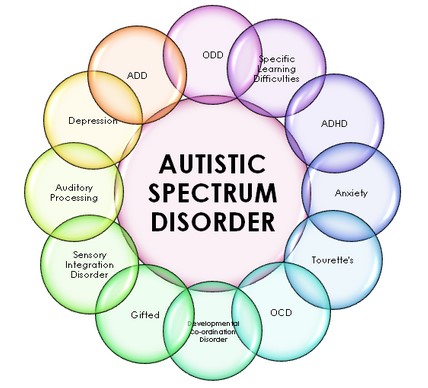Autism Spectrum Disorder (ASD): Exploring the Different Types
 Autism Spectrum Disorder (ASD) is a complex neurological disorder that affects the way individuals interact with their environment and communicate with others. It is a spectrum disorder, meaning that it affects individuals differently and to varying degrees. People with ASD may experience difficulties with social interaction, communication, and repetitive behaviors. ASD can range from mild to severe, and can affect individuals of all ages, genders, and backgrounds. It is important to understand the different types of ASD and the various ways it can manifest in order to provide the best support and care for those affected.
Autism Spectrum Disorder (ASD) is a complex neurological disorder that affects the way individuals interact with their environment and communicate with others. It is a spectrum disorder, meaning that it affects individuals differently and to varying degrees. People with ASD may experience difficulties with social interaction, communication, and repetitive behaviors. ASD can range from mild to severe, and can affect individuals of all ages, genders, and backgrounds. It is important to understand the different types of ASD and the various ways it can manifest in order to provide the best support and care for those affected.
Exploring the Different Types of Autism Spectrum Disorder (ASD): A Comprehensive Guide
Autism Spectrum Disorder (ASD) is a complex neurological disorder that affects individuals in different ways. It is characterized by difficulties in communication, social interaction, and behavior. ASD is a spectrum disorder, meaning that it can range from mild to severe, and the symptoms and severity of the disorder can vary greatly from person to person.
This guide will provide an overview of the different types of ASD, as well as the signs and symptoms associated with each type. It will also discuss the various treatments and interventions available for individuals with ASD.
The first type of ASD is Autistic Disorder, also known as classic autism. This type of ASD is characterized by difficulties in communication, social interaction, and behavior. Individuals with Autistic Disorder may have difficulty understanding social cues, making eye contact, and engaging in conversations. They may also have difficulty with motor skills, such as handwriting and tying shoelaces.
The second type of ASD is Asperger Syndrome. Individuals with Asperger Syndrome may have difficulty with social interaction, but they typically have better language and communication skills than those with Autistic Disorder. They may also have difficulty with motor skills, but they may be able to engage in conversations and understand social cues better than those with Autistic Disorder.
The third type of ASD is Pervasive Developmental Disorder Not Otherwise Specified (PDD-NOS). Individuals with PDD-NOS may have some of the same symptoms as those with Autistic Disorder and Asperger Syndrome, but they may not meet the full criteria for either disorder.
The fourth type of ASD is Childhood Disintegrative Disorder (CDD). This type of ASD is characterized by a sudden and severe regression in language, social, and motor skills. Individuals with CDD may have difficulty with communication, social interaction, and behavior.
The fifth type of ASD is Rett Syndrome. This type of ASD is characterized by a regression in language, social, and motor skills. Individuals with Rett Syndrome may have difficulty with communication, social interaction, and behavior.
Finally, the sixth type of ASD is Childhood Autism Rating Scale (CARS). This type of ASD is characterized by difficulties in communication, social interaction, and behavior. Individuals with CARS may have difficulty with motor skills, such as handwriting and tying shoelaces.
No matter what type of ASD an individual has, there are treatments and interventions available to help them manage their symptoms. These treatments and interventions may include speech and language therapy, occupational therapy, social skills training, and behavior therapy. It is important to work with a qualified professional to determine the best treatment plan for an individual with ASD.
This guide has provided an overview of the different types of ASD, as well as the signs and symptoms associated with each type. It has also discussed the various treatments and interventions available for individuals with ASD. With the right support and treatment, individuals with ASD can lead fulfilling and successful lives.
Understanding the Causes and Symptoms of Autism Spectrum Disorder (ASD)
Autism Spectrum Disorder (ASD) is a complex neurodevelopmental disorder that affects a person’s ability to communicate, interact, and behave in social situations. It is a lifelong condition that affects individuals differently, and can range from mild to severe.
The exact cause of ASD is unknown, but research suggests that it is likely caused by a combination of genetic and environmental factors. Studies have identified a number of genes that may be associated with ASD, and environmental factors such as exposure to certain toxins or infections during pregnancy may also play a role.
The symptoms of ASD vary from person to person, but generally include difficulties with social interaction, communication, and repetitive behaviors. People with ASD may have difficulty understanding social cues, such as facial expressions and body language, and may have difficulty making and maintaining friendships. They may also have difficulty expressing themselves verbally, and may use language in an unusual way. Repetitive behaviors are also common, such as hand-flapping, rocking, or repeating words or phrases.
It is important to remember that ASD is a spectrum disorder, and that individuals with ASD may have different levels of functioning. Some may be able to live independently, while others may need more support. With early diagnosis and intervention, individuals with ASD can learn to manage their symptoms and lead fulfilling lives.The different types of Autism Spectrum Disorder (ASD) can be complex and difficult to understand. However, it is important to recognize that each individual with ASD is unique and has their own set of strengths and challenges. With the right support and understanding, individuals with ASD can lead fulfilling and meaningful lives. It is essential to continue to explore the different types of ASD in order to better understand the disorder and provide the best possible support for those affected.